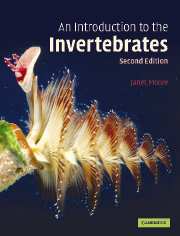Book contents
- Frontmatter
- Contents
- List of boxes
- Preface
- Acknowledgements
- Illustration acknowledgements
- Chapter 1 The process of evolution: natural selection
- Chapter 2 The pattern of evolution: methods of investigation
- Chapter 3 Porifera
- Chapter 4 Cnidaria
- Chapter 5 On being a worm
- Chapter 6 Platyhelminthes and Acoelomorpha
- Chapter 7 Nemertea
- Chapter 8 Nematoda
- Chapter 9 Annelida
- Chapter 10 Mollusca: general and Gastropoda
- Chapter 11 Mollusca: Bivalvia and Cephalopoda
- Chapter 12 Arthropoda: general
- Chapter 13 Crustacea
- Chapter 14 Chelicerata and Myriapoda
- Chapter 15 Insecta
- Chapter 16 Animals with lophophores
- Chapter 17 Echinodermata
- Chapter 18 Invertebrate Chordata and Hemichordata
- Chapter 19 Development
- Chapter 20 Invertebrate evolutionary history
- Further reading
- Glossary
- Index
Chapter 12 - Arthropoda: general
Published online by Cambridge University Press: 05 September 2012
- Frontmatter
- Contents
- List of boxes
- Preface
- Acknowledgements
- Illustration acknowledgements
- Chapter 1 The process of evolution: natural selection
- Chapter 2 The pattern of evolution: methods of investigation
- Chapter 3 Porifera
- Chapter 4 Cnidaria
- Chapter 5 On being a worm
- Chapter 6 Platyhelminthes and Acoelomorpha
- Chapter 7 Nemertea
- Chapter 8 Nematoda
- Chapter 9 Annelida
- Chapter 10 Mollusca: general and Gastropoda
- Chapter 11 Mollusca: Bivalvia and Cephalopoda
- Chapter 12 Arthropoda: general
- Chapter 13 Crustacea
- Chapter 14 Chelicerata and Myriapoda
- Chapter 15 Insecta
- Chapter 16 Animals with lophophores
- Chapter 17 Echinodermata
- Chapter 18 Invertebrate Chordata and Hemichordata
- Chapter 19 Development
- Chapter 20 Invertebrate evolutionary history
- Further reading
- Glossary
- Index
Summary
Arthropods are segmented animals with an outer cuticle, the exoskeleton, which is typically hardened and inflexible over much of the body but remains flexible at joints; the muscles are attached inside this cuticle. Like a molluscan shell it protects the soft parts, but, unlike a shell, the arthropod cuticle is built into the animal. With jointed limbs, fast-contracting striated muscle and a well-developed nervous system, rapid locomotion can be achieved.
The arthropod body plan has proved outstandingly successful. Arthropods constitute nearly nine-tenths of all known animal species, occurring in the sea, in fresh water, on land and in the air, in every conceivable ecological niche. Not only are they many and diverse as species (at least a million have been described) but also they are numerous as individuals, for example there are about 1021 copepod crustaceans in the oceans and some 200 million insects are said to exist for every human being on earth.
The outstanding success of arthropods is largely attributable to the nature of the cuticle. This is the primary theme of this introduction to the arthropods. The diversity of arthropods is described in the three following chapters, with emphasis on evolution from the sea to fresh water and land. Chapter 13 introduces the Crustacea, which are mainly aquatic. Chapter 14 includes Chelicerata, the marine horseshoe crabs and terrestrial arachnids, and also Myriapoda, all terrestrial. Chapter 15 discusses Insecta, which are nearly all terrestrial as adults, and often aerial.
- Type
- Chapter
- Information
- An Introduction to the Invertebrates , pp. 153 - 167Publisher: Cambridge University PressPrint publication year: 2006



